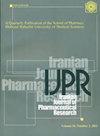PAG 可掩盖 5/6 肾切除大鼠因体育锻炼引起的高 H2S 水平
IF 1.8
4区 医学
Q3 PHARMACOLOGY & PHARMACY
引用次数: 0
摘要
背景:为了研究运动疗法在慢性肾脏病(CKD)临床前动物模型中的作用机制,我们使用硫化氢生成抑制剂 PAG(D, L-丙炔基甘氨酸)来研究体育锻炼对 CKD 期间氧化应激和炎症水平的保护作用。研究方法通过 5/6 肾切除术诱导患有 CKD 的雄性 Wistar 大鼠,并对其进行为期 8 周的运动训练,在这 8 周内每周两次注射胱硫醚 γ-lyase (CSE) 抑制剂 PAG,剂量为 19 毫克/千克。对收缩压(BP)和肾交感神经活性(RSNA)进行了评估。此外,还评估了血浆肌酐、尿素氮、肾硫化氢(H2S)水平、氧化应激和炎症指标。结果在 PAG 组中,抑制 H2S 生成明显逆转了运动对血浆肌酐、BUN、肾丙二醛 (MDA) 水平、超氧化物歧化酶 (SOD) 活性、TNF-α 和 IL-6 的改善作用。此外,与接受运动训练的 CKD 组相比,PAG 组的高 RSNA 和高血压也得到了逆转。结论:结果表明,运动对 CKD 患者血压、氧化应激和炎症状态的改善至少部分归因于 CSE/H2S 信号传导。本文章由计算机程序翻译,如有差异,请以英文原文为准。
PAG Masked Protective Physical Exercise-Induced High H2S Levels in 5/6 Nephrectomized Rats
Background: To investigate the mechanisms of exercise therapeutics in preclinical animal models of chronic kidney disease (CKD), PAG (D, L-propargylglycine), an inhibitor of hydrogen sulfide production, was used to examine the protective effects of physical activity on oxidative stress and inflammation levels during CKD. Methods: Male Wistar rats with CKD, induced by the 5/6 nephrectomy procedure and subjected to 8 weeks of exercise training, received injections of PAG, a cystathionine γ-lyase (CSE) inhibitor, at a dose of 19 mg/kg, i.p., twice a week during those 8 weeks. The systolic blood pressure (BP) and renal sympathetic nerve activity (RSNA) were assessed. Additionally, plasma creatinine, BUN, renal hydrogen sulfide (H2S) levels, oxidative stress, and inflammatory markers were evaluated. Results: In the PAG group, inhibition of H2S production significantly reversed the improvements in plasma creatinine, BUN, renal malondialdehyde (MDA) level, superoxide dismutase (SOD) activity, TNF-α, and IL-6 that were achieved by exercise. Additionally, high RSNA and high BP, which were also reversed in the PAG group, compared to the CKD group subjected to exercise training. Conclusions: The results suggest that the improvement in BP, oxidative stress, and inflammation status by exercise in CKD may be at least partially due to CSE/H2S signaling.
求助全文
通过发布文献求助,成功后即可免费获取论文全文。
去求助
来源期刊
CiteScore
3.40
自引率
6.20%
发文量
52
审稿时长
2 months
期刊介绍:
The Iranian Journal of Pharmaceutical Research (IJPR) is a peer-reviewed multi-disciplinary pharmaceutical publication, scheduled to appear quarterly and serve as a means for scientific information exchange in the international pharmaceutical forum. Specific scientific topics of interest to the journal include, but are not limited to: pharmaceutics, industrial pharmacy, pharmacognosy, toxicology, medicinal chemistry, novel analytical methods for drug characterization, computational and modeling approaches to drug design, bio-medical experience, clinical investigation, rational drug prescribing, pharmacoeconomics, biotechnology, nanotechnology, biopharmaceutics and physical pharmacy.

 求助内容:
求助内容: 应助结果提醒方式:
应助结果提醒方式:


